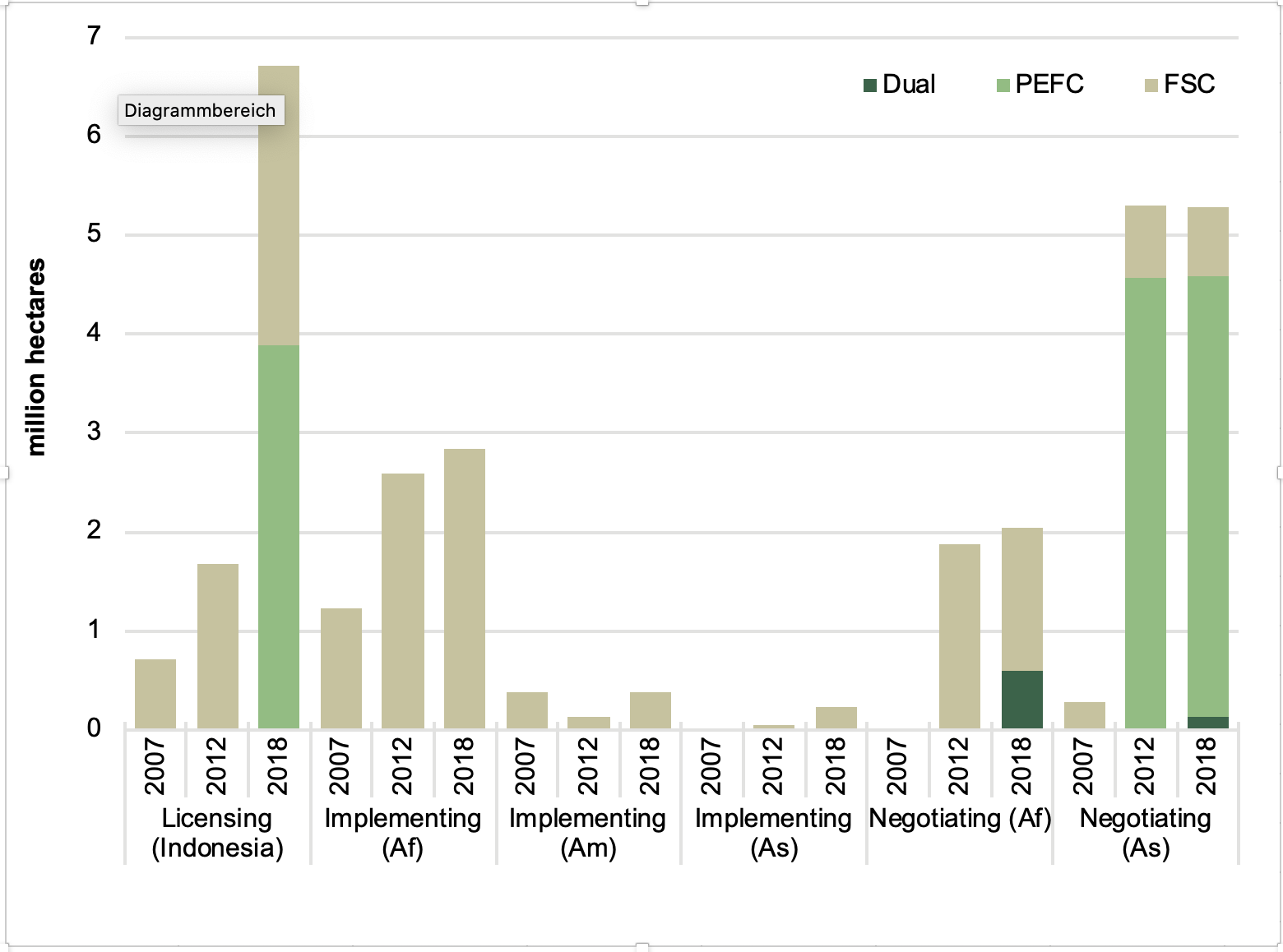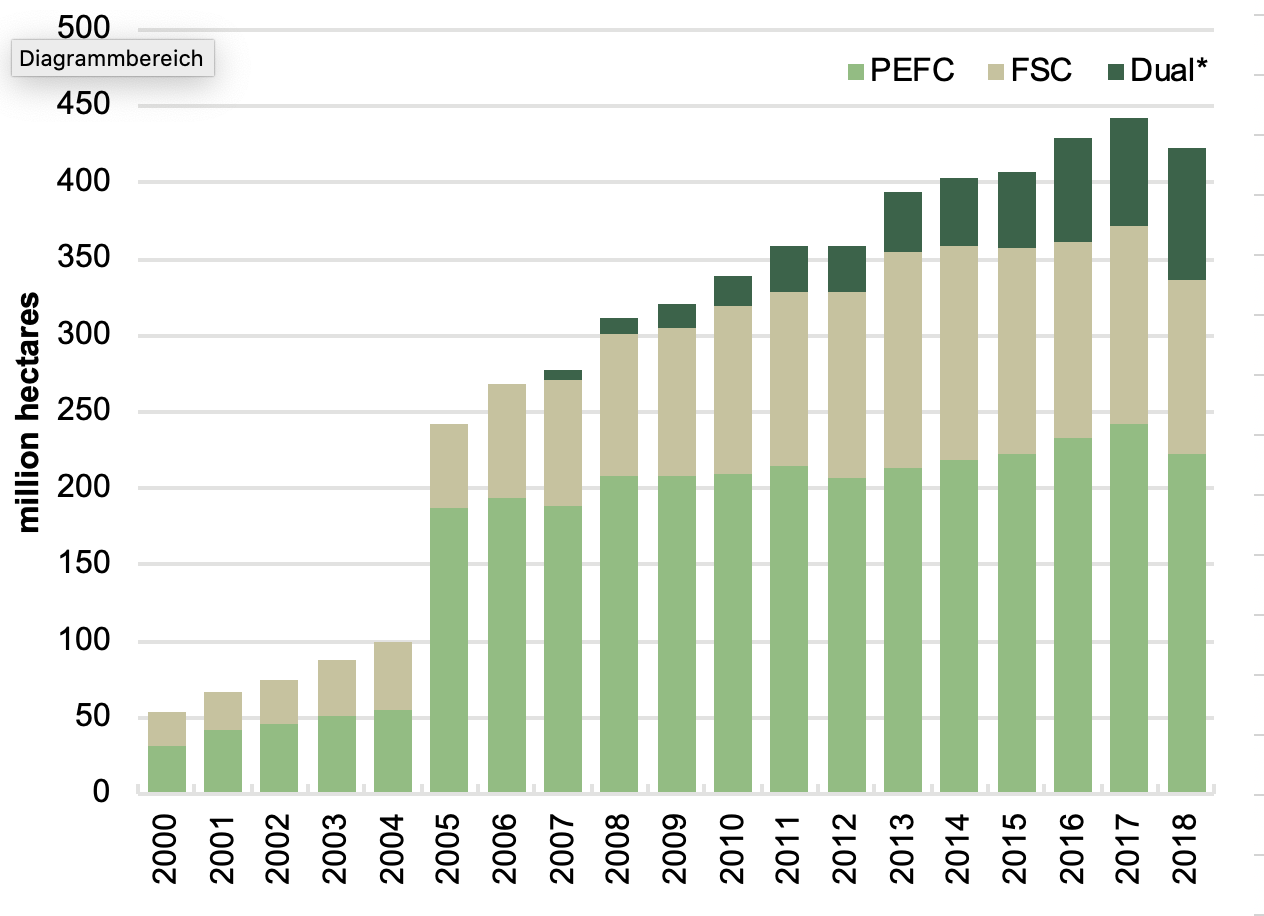Overall progress of third-party certification under the FSC and PEFC frameworks in VPA partner countries was slow before efforts to develop FLEGT licensing systems began and, in most countries, progress has remained slow during the period of TLAS implementation. Total FSC and PEFC certified area in all VPA Partner countries was 17.5 million hectares in 2018, up from 11.62 million hectares in 2012 and less than 3 million hectares in 2007. While the rate of increase is impressive, in 2018 less than 4% of total forest area in VPA partner countries was certified and around 80% of the certified area was in just two of the 15 countries, Indonesia (38%) and Malaysia (42%).
Indonesia is the only VPA Partner country where significant progress was made to expand the area of third party certified forest in the 6 year period between 2012 and 2018 (Figure 1).
Figure 1: FSC and PEFC certified forest area in VPA Partner countries, by certification system and FLEGT VPA status

Source: IMM analysis of FSC and PEFC data
Considering only FSC and PEFC certification, certified area in Indonesia increased from 1.68 million hectares in 2012 to 6.7 million hectares in 2018. Despite the progress, FSC and PEFC certified forest area represented only 7.4% of total Indonesian forest area and was dwarfed by the 23 million hectares certified to PHPL, Indonesia’s national sustainable forest management standard.
Total certified area in the five African VPA implementing countries, all under the FSC system, more than doubled to 2.6 million hectares between 2007 and 2012 but added only another 200,000 hectares by the end of 2018. Between 2012 and 2018, an increase of 800,000 hectares in FSC certified forest area in RoC, to 2.4 million hectares, was offset by a 600,000 hectare decline in Cameroon, to 400,000 hectares. There is negligible certified forest area in all other VPA-implementing countries, both in Africa and other regions.
Total PEFC and FSC certified forest area in Malaysia, nearly all under the PEFC-endorsed MTCS system and concentrated in Peninsular Malaysia, increased 4% to 5.2 million hectares between 2012 and 2018. Only a tiny fraction of forest in Thailand and Lao PDR was certified in 2018. Of the three VPA-negotiating countries in Africa, only Gabon had any certified forest in 2018. After rising from zero to 1.9 million hectares between 2007 and 2012, the area of FSC certified forest in Gabon increased by only 180,000 hectares between 2012 and 2018. In 2017, a 600,000 hectare concession in Gabon, already FSC certified, became the first area to be certified by the PEFC-endorsed Pan African Forest Certification (PAFC) system. In 2018, President Ali Bongo announced that all forest concessions in Gabon would have to implement FSC certification by 2022; this plan was later revised and now recognises other forms of certification.
The slow pace of uptake of FSC and PEFC certification in most VPA partner countries between 2012 and 2018 is part of a wider global slowdown. Worldwide, the total certified area of forest reported in December 2018 was 200 million hectares by FSC and 310 million hectares by PEFC. Data issued jointly by FSC and PEFC in January 2019 shows a high degree of overlap, 87 million hectares of forest worldwide being certified by both frameworks (Figure 2).
Figure 2: FSC and PEFC global certified forest area, by certification system, 2000 to 2018

Source: IMM analysis of FSC, PEFC & UNECE data
In the decade between 2004 and 2013, the total global area of forest certified by either FSC or PEFC quadrupled from 100 million hectares to nearly 400 million hectares, rising by 30 million hectares per year on average. However, in the next four years, certified forest area increased at an average rate of only 12 million hectares per year, to a peak of 442 million hectares in 2017.
In 2018, the global area of certified forest recorded the first ever annual decline. Although FSC reported static certified forest area and PEFC only a 1% decline, when a significant rise in dual certification to both FSC and PEFC during the year is taken into account, the total area is estimated to have declined 4% to 423 million hectares in 2018. Although certified forest area continued to rise in Russia and Belarus, this was offset by a larger decline in certified area, with a particularly large fall in Australia during 2018. At the end of 2018, global certified forest accounted for 11% of global forest area, only a marginal increase from around 10% in 2012.
Of total global FSC and PEFC certified forest area in 2018, only around 25 million hectares (6%) was in tropical regions compared to over 400 million hectares (94%) in non-tropical regions (Figure 3).
Figure 3: Total forest and FSC and PEFC certified forest area, by certification system and global region

Source: IMM analysis of FAO Forest resource Assessment and FSC and PEFC
The slow progress of certification in most VPA partner countries is mirrored in other tropical timber supplying countries not engaged in the VPA process. Brazil is the only non-VPA country with a large tropical forest area where there is also a significant area of certified forest. In 2018 there was 7.93 million hectares of certified forest in Brazil including 3.57 million hectares certified by both FSC and PEFC, 3.04 million hectares certified just by FSC, and 240,000 hectares certified just by PEFC. While the area dual certified in Brazil tripled between 2012 and 2018, the total area of certified forest increased by only 300,000 hectares. Only around 1.5 million hectares of certified forest in Brazil is natural tropical forest, the remainder comprising plantations with a large proportion outside the tropical zone.
There is no PEFC certification and only a small area of FSC certified forest in all other non-VPA countries in the tropics that are significant timber suppliers (Figure 4). Bolivia had 2 million hectares of FSC certified forest in 2007, but this has had fallen by 50% to under 1 million hectares in 2018. FSC certified forest area in Peru increased 30% to 920,000 hectares between 2007 and 2012 but had fallen to 810,000 hectares in 2018. India is the only other non-VPA tropical country with anything other than negligible certified forest area, although in 2018 this extended to just over 500,000 hectares, having increased by 100,000 hectares in the previous five years and accounting for less than 1% of total forest area.
Figure 4: Certified forest area (all FSC) in leading non-VPA tropical timber supplying countries

Source: IMM analysis of FSC and PEFC data
There are indications that certified area globally is becoming more concentrated in larger state and industry forest enterprises at the expense of smaller community and other non-industrial operators. At least half of all newly certified FSC and PEFC forest in the 2012 to 2018 period was in Russia and likely to comprise large state-owned and operated management units. Much of the rest was in Belarus, Ukraine, Sweden, Canada, and Norway where most forest production is concentrated in larger state and corporate management units.
